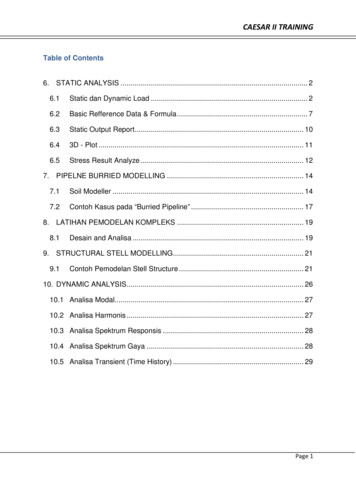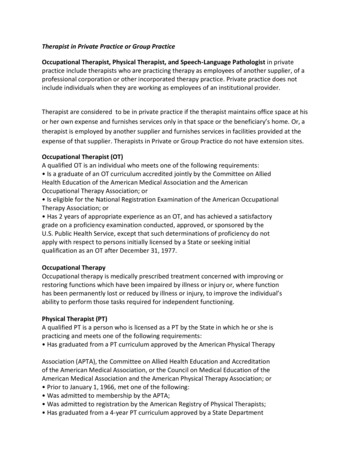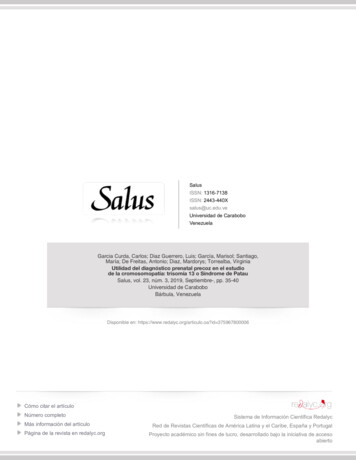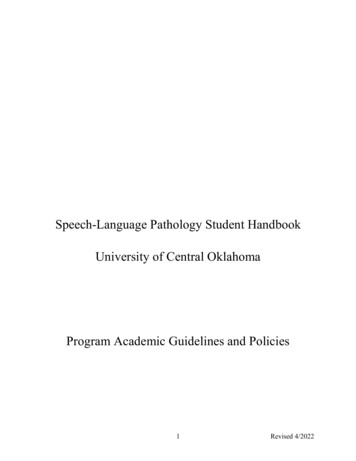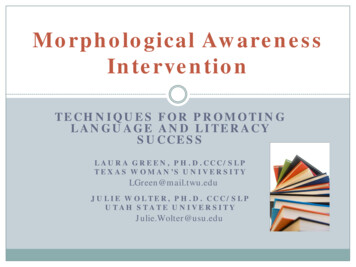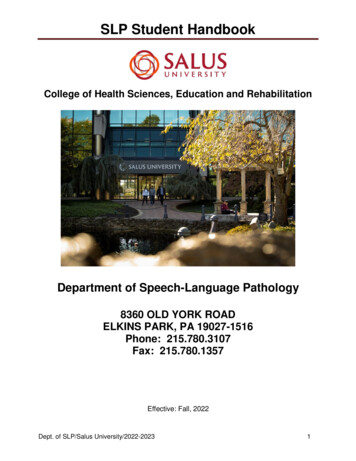
Transcription
SLP Student HandbookCollege of Health Sciences, Education and RehabilitationDepartment of Speech-Language Pathology8360 OLD YORK ROADELKINS PARK, PA 19027-1516Phone: 215.780.3107Fax: 215.780.1357Effective: Fall, 2022Dept. of SLP/Salus University/2022-20231
SLP Student HandbookMission of the Department:The mission of the Department of Speech-LanguagePathology is to educate and train graduate-level students tobecome exemplary professionals in speech-languagepathology who provide excellence in service delivery toindividuals with communication and swallowing disorders,and who engage in and promote interprofessional educationand practice, lifelong learning and prevention ofcommunication and swallowing disorders.Mission of the College:The mission of the College of Health Sciences, Educationand Rehabilitation (CHER) is to develop and offer graduateprograms preparing highly qualified professionals to supportindividuals who have, or are at risk for, disabilities, bycreating an interprofessional environment of practitionerscommitted to lifelong learning, critical thinking, anddedication to the individuals and communities they serve.Mission of the University:Advancing integrated health care through innovativeeducation, research and clinical services.Dept. of SLP/Salus University/2022-20232
SLP Student HandbookDepartment of Speech-Language PathologyCollege of Health Sciences, Education and RehabilitationSalus University8360 Old York RoadElkins Park, PA 19027215.780.3114 (Telephone)215.780.1357 (Fax)Speech-Language InstituteSalus University8380 Old York Road, Suite 2100Elkins Park, PA 19027215.780.3150 (Telephone)215.780.3169 (Fax)CHAIR/PROGRAM DIRECTOR:DIRECTOR OF CLINICAL EDUCATION:Robert Serianni, M.S., CCC-SLP, FNAP218.780.3107rserianni@salus.eduKara Maharay M.S. CCC-SLP, BCS-S215.780.1377kmaharay@salus.eduSLP STUDENT HANDBOOKThis handbook, required as a text for the student enrolled in the program, is intended to serve as aguide concerning the policies and procedures of the program at Salus University. Explanationsand examples of requirements, formats, and information pertinent to the student’s successfulcompletion of the program are included. If, at any time, a student is uncertain about policies orprocedures, or finds requirements unclear, they are strongly encouraged to seek clarification fromthe program director, the director of clinical education, faculty, or clinical supervisors.Should any change or update in this handbook be required, the program director will provide it asan addendum.Dept. of SLP/Salus University/2022-20233
SLP Student HandbookDEPARTMENT OF SPEECH-LANGUAGE PATHOLOGY OFFICESFaculty & StaffLocationRoleBergstrom, JenniferW337BAssistant ProfessorCardamone, ErikaN2113Clinical EducatorCatalini, JacquelynN2113Clinical EducatorCondon, RachaelN2113Clinical EducatorDavidoff, BethW328Assistant ProfessorDeMilia, SusanN2113Clinical EducatorDowns, JenniferN2113Clinical EducatorEdmonds, KimberlyW325Coordinator Post-Baccalaureate ProgramSLP; InstructorEvans, TaylorN2104SLI Office ManagerFinkelstein, AlisonN2113Clinical EducatorGoldynia, KristineN2113Clinical EducatorGrogg, M. JillN2113Clinical EducatorJett, EmilyN2113Clinical EducatorKelly, SusanneN2113Clinical EducatorKoza, JudithN2113Clinical EducatorLant, Christine3W Reception Area Administrative AssistantMaharay, KaraW334Director of Clinical Education; InstructorMayro, PatriciaW331Assistant ProfessorDept. of SLP/Salus University/2022-20234
SLP Student HandbookMoppert, CaitlinN2113Clinical EducatorMorton, LeahN2113Clinical EducatorPittam, JacquelineN2113Clinical EducatorRuckdeschel, AnneMarieW332InstructorSalmon, KellyW329Assistant ProfessorSchmuckler, SaraN2113Clinical EducatorSerianni, RobertW333Chair/Program Director; AssociateProfessorSlott, ShelleyN2113Clinical EducatorSmith, EricN2113Clinical EducatorSnyder, KellyN2113Clinical EducatorVesay, JoanneN2113Clinical EducatorWard, ReginaN2113Clinical EducatorYoder-Black, DeannaW337AAssistant ProfessorDept. of SLP/Salus University/2022-20235
SLP Student HandbookTABLE OF CONTENTSPAGESection 1.Introduction to Clinical Education12Roles and ResponsibilitiesStudent ResponsibilitiesClinical Educator ResponsibilitiesAcademic Advisor ResponsibilitiesDirector of Clinical Education ResponsibilitiesProgram Director ResponsibilitiesAmount of Supervision13131313131314The Clinical PracticumClinical SupervisorsPracticum AssignmentsClinic Time ExpectationsMandatory Meetings/OrientationClinical Clock Hour RequirementsTransfer of Clinical Clock HoursClinical Clock Hour RecordsActivities that count as clock hours includeActivities that do not count as clock hours14141515151516161616CALIPSORegistration – Initial UseInstructions for CALIPSOCALIPSO Scoring16161717Practicum Grading17Sequencing of Course Content and Clinical Experiences18Academic and Clinical Performance and Student ResponsibilitiesGradesProgram Review and Remediation PlansAcademic Remediation PlansClinical Remediation PlansFaculty Review181819192020Section 2.Protocols for ServicesScheduling and Pre-Evaluation InformationProcedures Prior to the Evaluation SessionProcedures on the Day of the EvaluationProcedures During the EvaluationProcedures Following the EvaluationScheduling for Treatment SessionsPreparationDept. of SLP/Salus University/2022-202321212122222323246
SLP Student HandbookProcedures Prior to the Treatment SessionProcedures During the Treatment SessionProcedures Following the Treatment SessionFormal Treatment Reports24242525Clinic Appropriate ActivitiesRelated to Direct Client CareRelated to Clinical Education252526Front Desk Assignments26Quality Assurance27Section 3.CAA ContactCriteriaSubmission Requirements272828Academic Rules and Student Academic Integrity29Non-Harassment and Anti-Discrimination Policy29Suspected Abuse/Neglect29ConfidentialityHIPAA Overview & TrainingFERPA Memorandum303031Whistleblower Policy31Drug and Alcohol-Free University Policy31Smoke-Free Campus Policy31Dependability31AttendanceAbsentee Procedure for ClinicLateness Procedure for ClinicEarly Departure Procedure for ClinicSupervisor Absences3232323233Clinic Closing/CancellationsSalus TimeSemester BreakJury DutyHolidays3333333333Dress Code34Identification Badge34Forms of Address34Immunization Records34Dept. of SLP/Salus University/2022-20237
SLP Student HandbookCriminal Background Check35Drug Testing35Cardiopulmonary Resuscitation (CPR) Training35Liability Insurance35Health Insurance35Transportation35Gifts/Gratuities35Cell Phone Usage36Electronic Communication and Social Media36Blackboard36Photocopier Procedures36Video Recordings36Disability Statement37Students Who Speak English with Accents and Non-Standard Dialects37Student Organization37Safety and Security37Emergency Text Messaging System38Parking38Infection Control ProceduresEnvironmental Infection Control & Basic Housekeeping PracticesSurface DisinfectionSurface Disinfection Will Incorporate the Following StepsControlling the Human Source of InfectionHand WashingPersonal Protective Equipment (Gloves, Gowns, and Masks)GlovesGownsMasks/Eye ProtectionFirst Aid KitEye Wash StationSpill Clean UpMaterial Safety Data Sheet (MSDS)3838383939393939394040404040Additional Infection Control Measures Due to COVID-19Cleaning and Disinfecting4040Client Accident/Illness Response Procedures40Crisis ServicesStages of Crisis ManagementServices414141Dept. of SLP/Salus University/2022-20238
SLP Student HandbookWhat If Mobile Crisis Supports Are Not Enough42Clinical Materials42Other Campus ResourcesTechnology and Library Services (TLS)The Learning Resource CenterAlcon LabBennett Career Services CenterOther Support Services424243434444Section 4.Certification LicensureASHA CertificationNational ExaminationClinical Fellowship YearSchool Certification4444444545Appendix A: Sequence of Education Experiences46Appendix B: Course Descriptions47Appendix C: Standards for Accreditation of Graduate Education Programs in Audiologyand Speech-Language Pathology53Appendix D: 2020 Standards and Implementation Procedures for the Certificate ofClinical Competence in Speech-Language Pathology58Appendix E: ASHA Scope of Practice in Speech-Language Pathology69Appendix F: ASHA Code of Ethics85Appendix G: Clinical Supervision in Speech-Language Pathology and Audiology93Appendix H: Essential Functions101Appendix I: FormsConsent for Evaluation and TreatmentConsent to Use Food in SessionClient Intake and ScheduleChild Case History FormAdult Case History FormEvaluation OutlineEvaluation SummaryTreatment Note (SOAP Format) OutlineProgress Note/Discharge Summary OutlineSpeech-Language Pathology SuperbillAdvance Beneficiary Notice (ABN)Client Satisfactory SurveyTherapy PlanClinical Reflection ToolStudent Self-Reflection of Evaluation 35136Dept. of SLP/Salus University/2022-20239
SLP Student HandbookStudent Self-Reflection of Treatment SessionSession Observation FormDescription of Observation ExperienceRemediation PlanClinical Practicum Progress LogAbsence from Clinical PracticumMaterial Reservation LogMaterials Tracking LogClinic Room ReservationPracticum Request QuestionnaireSite Orientation ChecklistFERPA MemorandumCommunication Proficiency ScreenerGraduate Student Portfolio 52Appendix J: State and National Resources153Acknowledgement Statement154Program Participant Agreement Statement154The Oath to Professionalism in the Health Sciences155Dept. of SLP/Salus University/2022-202310
SLP Student HandbookWelcome to the Department of Speech-Language Pathology!The faculty and staff of the Department of Speech-LanguagePathology in the College of Health Sciences, Education andRehabilitation at Salus University are excited that you will be joiningus for your graduate studies! We will make every effort to provideyou with a high-quality learning experience that exposes you to thedepth and breadth of the profession across a variety of settings.The purpose of the handbook is to support student learning duringyour education in the Master’s program. The faculty has developedthis handbook as a resource containing the guidelines relevant tothe program as well as the Speech-Language Institute (SLI) andbeyond. You will find information about the policies and proceduresassociated with the program, along with some details about whatyou need to do to prepare for professional practice after yougraduate.So, please look through the handbook carefully and become familiarwith its contents.When you have questions about the program, we encourage you toconsult the handbook first – there’s a very good chance that you’llfind the answers to your questions right here! Of course, if theanswers aren’t evident, just let us know. We’ll be happy to assistyou in achieving the goal to provide a quality experience for ourstudents.Dept. of SLP/Salus University/2022-202311
SLP Student HandbookINTRODUCTION TO CLINICAL EDUCATIONSupervised clinical practice is an integral part of the graduate program in the Department ofSpeech-Language Pathology within the College of Health Sciences, Education and Rehabilitationat Salus University. Supervision provides the student with an opportunity to apply knowledge tothe evaluation and management of individuals with a wide variety of communication disorders.The primary goal of clinical education is to prepare speech-language pathologists who willdemonstrate general competence across the scope of practice in nine communication disordersareas from infancy to geriatrics of culturally and linguistically diverse populations. Clinicalexperiences (a minimum of 400 clock hours) are required in each of the following areas: Articulation, including production of phonemes, strategies to improve motor speechproduction, production of multisyllabic word forms.Fluency, including stuttering behaviors, cluttering and rate of production.Voice and resonance, including respiration and phonation, pitch and intonation variations.Receptive and expressive language (morphology, phonology, syntax, semantics, andpragmatics) in speaking, listening, reading, writing and manual modalities, includingincreased length and complexity of utterances, expanding expressive/receptive vocabulary,measurements/treatment of phonological use.Hearing, and its impact on speech and language and aural (re)habilitation, includinghearing aid troubleshooting, hearing screening, speech reading skills, speech/voiceproduction and language deficits as influenced by hearing impairment.Swallowing disorders, including oral, pharyngeal, esophageal, and related functions aswell as oral function for feeding; may include modified barium swallow measures, fiberoptic evaluation of swallowing, and strategies to decrease aspiration.Cognitive aspects of communication (attention, memory, sequencing, problem-solvingand executive functioning), including cognitive notebook use to improve access to longterm memory about family and word retrieval strategies.Social aspects of communication for challenging behavior, ineffective social skills, andlack of communicative opportunities, including behavior management techniques anddeveloping more effective peer interaction patterns.Communication modalities, including oral, manual, augmentative and alternativecommunication (AAC) techniques and assistive technology, identifying appropriate AACdevices and strategies, increasing use of effectiveness of AAC techniques.Through sequenced clinical experiences and assignments, the student will learn to: Analyze, synthesize and evaluate an extensive body of knowledge in communicationsciences and disorders.Use evidence-based practices in the selection of evaluation and treatment protocols.Achieve high levels of competency in prevention, screening, diagnosis, and treatment ofclients with varied communication disorders.Communicate effectively and professionally, orally and in writing.Demonstrate ethical and responsible professional conduct.The ultimate goal of clinical education is to provide the student with the knowledge and skills topractice as a speech-language pathologist in diverse clinical settings across the lifespan.Dept. of SLP/Salus University/2022-202312
SLP Student HandbookROLES AND RESPONSIBILITIES IN CLINICAL EDUCATIONStudent ResponsibilitiesThe student is expected to conform to the policies and procedures of the site at which thepracticum takes place. Essentially, the student learns the role of the professional by following themodel of the supervisor. The rules and expectations will be discussed at the beginning of theassignment and will vary depending on the site. The student will: Assist the supervisor in selecting and administering the appropriate diagnostic tools Set realistic and appropriate therapy objectives Select techniques and materials for implementing the therapy objectives Manage client behavior Motivate clients Document session with professional notes/reports Counsel clients and parents/caregivers Implement suggestions made by supervisors in a timely fashion Act as a member of the professionClinical Educator ResponsibilitiesThe clinical educator will discuss the expectations for the student as early as possible in thepracticum. This will allow students time to address any concerns regarding supervision approach,methods of feedback, and administrative matters. In order to assure that the student is competent,the clinical supervisor will: Observe assessment and therapy sessions as required by CFCC guidelines Provide feedback (both written and oral) about assessment protocols, treatment plans,therapy sessions and documentation in real-time and during weekly meetings Demonstrate techniques to facilitate student learning Suggest alternatives for achieving goals Participate in counseling sessions Give the student support and direction while allowing the student independence to planand problem solve Assist the clinical director in formalizing mid-term and final gradesRecommendations regarding care of the client or to the parent/caregiver are the responsibility ofthe clinical educator.Academic Advisor ResponsibilitiesThe academic advisor will be responsible for advising the student in both didactic and clinicaleducation. The advisor will provide support to the student, the clinical educator and othersupervisors during the student’s practicum experience.Director of Clinical Education ResponsibilitiesThe director of clinical education will be responsible for coordinating all clinical activities for thestudents, both on and off-campus. The director or designee will observe sessions to determinethe effectiveness of the practicum for both the student and the supervisor and make suggestionsfor any adjustment to the practicum. The director will submit grades for all practicum courses.Program Director ResponsibilitiesThe program director will be responsible for overseeing the entirety of the program and guiding thestudents towards meeting the requirements for graduation.Dept. of SLP/Salus University/2022-202313
SLP Student HandbookAmount of SupervisionAccording to Standard V-E of the 2020 Standards and Implementation Procedures for theCertificate of Clinical Competence in Speech-Language Pathology:Supervision of students must be provided by a clinical educator who holds ASHA certification inthe appropriate profession and who, after earning the CCC-A or CCC-SLP, has completed (1) aminimum of nine months of full-time clinical experience, and (2) a minimum of two hours ofprofessional development in clinical instruction/supervision.The amount of direct supervision must be commensurate with the student’s knowledge, skills, andexperience; must not be less than 25% of the student's total contact with each client/patient; andmust take place periodically throughout the practicum. Supervision must be sufficient to ensure thewelfare of the individual receiving services. (ASHA, 2020)THE CLINICAL PRACTICUMThroughout the course of studies, the student must complete a minimum of 400 clinical hours. Thestudent completes at least 25 hours of observation and at least 375 hours of direct client contact.These clinical hours are to be achieved through a variety of practice settings with a diversity ofclients. For all students, clinical educators will determine when students are able to move fromsupervised observation into supervised clinical service delivery. This decision will differ dependingupon the knowledge and abilities of the student and the specific clinical procedures performed.Typically, coursework related to a procedure should be concurrent or completed prior to clinicalparticipation involving that procedure. All students will rotate through placements in the on-campusclinic and formally approved off-campus sites. Students may only attend sites that are approved bythe program, for which a current affiliation agreement is in place.When a student enrolls in a clinical practicum, it is expected that the student will participatethrough the end of the designated clinical assignment (i.e., one semester).Throughout the program, students will meet with the director of clinical education, the academicadvisor and the supervisor(s) to discuss on-campus and off-campus clinical placements.Determination of the clinical placements will depend on knowledge, skills, abilities, and schedule.Students may expect to be placed in the on-campus clinic for three semesters beforeconsideration of off-campus placements. The director of clinical education or designee will makethe initial contact to inquire if an off-campus site is willing to supervise a student extern. Once thesite has indicated willingness to supervise a student and the program has verified that a signedagreement is in place, the student will be offered the name and contact information so that he orshe may further discuss the placement and set up any needed preliminary interview or site visit.Clinical SupervisorsAll supervisors will hold the American Speech-Language Hearing Association (ASHA) Certificateof Clinical Competence. ASHA certification will be verified by the program’s administrativeassistant, working closely with the director of clinical education, through the ASHA website.Verification will occur prior to the first placement of students with a supervisor and then occur onan annual basis, on or about January 1.All supervisors of students will also be required to maintain state licensure and/or certification, asapplicable, in the state where the practicum occurs. This too will be verified by the program’sadministrative assistant, working closely with the director of clinical education. Verification willoccur prior to the first placement of students with a supervisor and then occur annually, on orDept. of SLP/Salus University/2022-202314
SLP Student Handbookabout July 1.Supervisors will also be asked to provide a signed declaration that they have and will maintainASHA certification and state licensure and/or certification while supervising as well as abide by theASHA Code of Ethics and Scope of Practice within their specialty(ies) and clinical setting.Supervisors will also be required to verify that they have completed a minimum of 9 months of fulltime, post-certification (or its part-time equivalent) clinical experience, and participated in at leasttwo hours of professional development/continuing education in clinical supervision. Any changesto credentialing during the student’s placement must be brought to the program’s attentionimmediately.Finally, supervisors’ contact information and credentialing will be placed in CALIPSO (see below),and updated regularly.Practicum AssignmentsStudents will follow the sequence of learning practicum assignments outlined by the program, inthe order specified. Practicum assignments will be sent via email to the student, the supervisorand the program chair two to four weeks before the new semester. The program will maintainregular contact with the student and the site throughout the semester to ensure onsite supervisionand clinical caseload is appropriate for each level.Different disorders may be encountered at different rotation settings each semester depending onthe clients/students/patients served. It is noted that depending on the type of setting, vocabularyand terminology will vary, and the student is expected to know and use the terminology of thesetting. For example, in a medical setting, those receiving services are referred to as patients, butin a school setting, they are referred to as students, and in a private practice or clinic setting, thosereceiving services are referred to as clients.Clinic Time ExpectationsEnrollment in clinic practicum and externships will place significant time demands on studentsduring the week. It is mandatory for students to remain in the clinic for the duration of theassignment block. For each assignment, students should be prepared to devote approximately 15to 20 hours per week during internship and up to 40 hours per week during externship to planning,implementing, and evaluating the clinical experiences.Mandatory Meetings/OrientationMany clinical practicum sites require meetings prior to beginning or at the onset of the assignment,including an interview, shadowing hours, and site orientation. If a student misses the requiredmeetings, then it is at the discretion of the program whether to allow the student into thepracticum. Students are responsible for attending all meetings as part of their clinical education.Clinical Clock Hour RequirementsThe Department of Speech-Language Pathology abides by the practicum requirements asprescribed by ASHA for the Certificate of Clinical Competence in Speech-Language Pathology(CCC-SLP), as well as requirements for state licensure and certification. Thus, students will needto meet the following minimum requirements for clinical practicum hours:Dept. of SLP/Salus University/2022-202315
SLP Student HandbookTotal Patient/Client ContactSupervised Clinical ObservationPatient/Client Contact400 hours25 hours (prerequisite requirement)375 hoursPlease note that other states may require a minimum number of clinical clock hours in evaluationand treatment of children and adults. Students will be responsible for identifying and tracking thoserequirements.Transfer of Clinical Clock HoursSalus University will accept the transfer of clinical hours earned at the undergraduate level. Aminimum of 325 clock hours of supervised clinical practicum must be completed while the studentis enrolled in the graduate program.Clinical Clock Hour RecordsThe Council for Clinical Certification in Audiology and Speech-Language Pathology (CFCC)defines 1 clinical practicum hour as equal to 60 minutes. When counting clinical practicum hoursfor purposes of ASHA certification, experiences/sessions that total less than 60 minutes (e.g., 45minutes or 50 minutes) cannot be rounded up to count as 1 hour.Students may count only those hours for which they have provided direct client care.Activities that count as clock hours include: Only direct contact with the client or the client'sfamily in assessment, management, and/or counseling can be counted toward the practicumrequirement.Activities that do not count as clock hours: Time spent on documentation, preparing for asession, preparing material, scoring and analyzing tests, calling client/family to makeappointments, conferencing on client with the supervisor, team meetings, or in rounds, observing asession or an IEP/IFSP meeting.At the end of each semester, clinical clock hours will be verified by the supervisor and the directorof clinical education and signed off by the department chair. Students should maintain apaper/hard copy of their signed clinical hours for their personal records.The student’s failure to submit clinical hours within the assigned time frame will result in a failure(F) for the clinical practicum course.CALIPSOThe Department of Speech-Language Pathology has adopted the Clinical Assessment of LearningInventory of Performance Streamlined Office Operations (CALIPSO), a competency-basedapplication that manages student clinical learning. To access Salus’ CALIPSO website, go to theCALIPSO login page and search for Salus University under the School Login tab.RegistrationTo gain access to the CALIPSO system, the student will be emailed a one-time PIN number by thedirector of clinical education. With the PIN number, the student will receive step-by-stepinstructions for using the system.Dept. of SLP/Salus University/2022-202316
SLP Student HandbookInstructions for CALIPSOStudents will find instructions for approving clock hours and submitting students’ midterm and finalevaluations on the CALIPSO website. All clock hours should be approved prior to the end of eachsemester by the supervising clinician.CALIPSO ScoringCALIPSO scoring is a competency-based program and adheres to the standards set forth by theCouncil on Academic Accreditation (CAA), and the Council for Clinical Certification (CFCC). Thismeans that students have to demonstrate specified clinical competencies in order to qualify forgraduation. Competencies on a standard are met when a student’s average on the standardreaches the minimum score as outlined in the course syllabus.Competency-Based Scores:1.2.3.4.5.Absent – supervisor modeling and intervention neededEmerging – supervisor intervention neededEvident – with supervisor support and feedbackIndependent – given occasional feedbackClinical Fellowship (CF)-ready – consultation with supervisorThe purpose of the rating system is to provide feedback on specific clinical competency areas andguide decisions in which students need practice or support. The supervisor will evaluate and gradethe student’s performance at midterm and at the end of the placement.A pass in a practicum course indicates that the student has met at least minimum requirements tocount clinical clock hours. Students will be evaluated across three major domains: (1) Evaluation,(2) Intervention and (3) Preparedness, Interaction and Personal Qualities. In order to receive apassing grade for the practicum, the student must have a minimum average competency in eachdomain as outlined in the course syllabus. Students may not count clinical hours towards theminimum required hours for graduation during a term when a failing grade is received.PRACTICUM GRADINGSatisfactory clinical performance is an integral part of the program's expectation of students. Eachstudent must enroll in clinical practicum each semester. Only the director of clinical education ordepartment chair, with approval from the dean, can waive this requirement.As part of the assessment process, students will be required to reflect on and write about theirclinical experiences, including their self-perceived strengths and areas for improvement. Thesereflections will be discussed with the clinical educator. The student’s assessments will becompared with the supervisor’s rating scale at mid-term and within the final two or three weeks oftheir clinical placement. The self-reflections may also be discussed during formal advisingsessions. The clinical supervisor and academic advisor will communicate as needed regardingthe student’s performance.At the midterm point of the semester, the clinical supervisor may provide formal assessment tostrengthen or improve observed areas of weakness and reinforce the student’s strengths.At the close of the semester, the supervisor provides summative assessment information toimprove observed areas of weakness and reinforce the student’s strengths. This exchange occursduring the final conference between the student and the clinical supervisor. Clinical educatorsDept. of SLP/Salus University/2022-202317
SLP Student Handbookrecommend a grade for the student’s work during the semester. The director of clinical education,in consultation with the student’s supervisors, assigns the final grade.Satisfactory clinical performance (i.e., direct clien
Program Director Responsibilities 13 . Amount of Supervision 14 . The Clinical Practicum 14 . Clinical Supervisors 14 . Practicum Assignments 15 . Clinic Time Expectations 15 . Lecture and lab provide students with a background in gross human anatomy using body parts of cadavers. Emphasis is on body structures supporting the speech, voice and .
